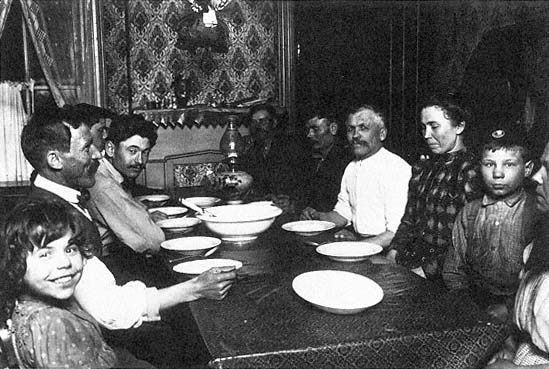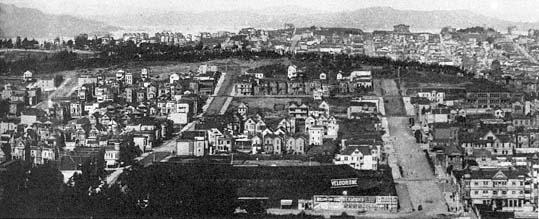Problems of Living with a Downtown Family
Boarding or lodging with a family was the major alternative to living in a commercial boardinghouse or rooming house, and it was also the most commonly chosen downtown life-style for young single men and women. For families in the middle and upper class, boarders were extra income, companionship, or people taken in as a favor to relatives. In such households, boarders often filled unused rooms. For wage-labor families with irregular incomes, boarders were essential. The income they

Figure 4.23
A Slavic boardinghouse dining room in a factory district near New York City, 1912. Photographed
by Lewis Hine.
provided helped to pay medical bills or make monthly payments on a looming seven-year mortgage with a balloon payment at the end. Boarding with families was particularly common in working-class family districts and family slums, often located next to rooming house districts because their residents depended on many of the same kinds of jobs (fig. 4.23).
Boarding with a family offered more traditional home-style conviviality, more social respectability, and generally better food than hotel life. Immigrants tended to board for only a short time and then set up independent households.[80] Unlike immigrants, American-born migrants to the city often chose boarding as a long-term housing choice. The eighteen-year-old lumber clerk, Will Kortum, had started his San Francisco life in a hotel in 1905 but soon wrote home that he planned to move in with a family in a nearby working-class district:
I am getting tired of this hotel and restaurant life and as soon as my pay is raised will look for board in a private family. . . . They say that . . . if you are lucky it is just like being at home.[81]

Figure 4.24
Flats and single-family houses at the edge of San Francisco, ca. 1890s. Roomers who stayed with families
in such settings were isolated from downtown life.
Kortum moved into a private boardinghouse on Eleventh Street, in the South of Market area, where he lived with the housekeepers—a young Swedish woman and her little girl—and seven other paying guests. He found that boarding with an immigrant family meant a sharp decline in personal comforts:
The meals are good, at least they are a great improvement in the restaurant fare, but otherwise there are but few comforts: no water in the room, poor bed, very small room, and bare of furniture. I shall look around for something better and wish I had never moved here at all.[82]
Kortum's new room supplied fewer personal needs independent of the boarding household. "My moving is an easily accomplished act," he said, "but costs 50 cents every time so I must be more careful."
This dissatisfaction with boarding with a family matched a general trend. Many boarders sought more independence and freer association with friends. Young people who lived in outlying family districts had a half-hour streetcar ride every time they wanted to visit companions, go dancing, or see a movie (fig. 4.24). Returning home, family boarders had to worry about missing the last streetcar for the night.[83] Other concerns were about privacy, as reported in this case:
"Miss G.," a public school music teacher, did not like rooming with a family. When she had phone calls, the family had to listen to one end of the conversation. If she slept late on Saturday morning she felt she was inconvenienc-
ing the family—and the children made such a ruckus she could not rest anyway. . . . She repeatedly took guests for a walk rather than use the parlor.[84]
Another woman complained, "The family from whom I rented a room were inquisitive and prying. I'm sure they investigated my room during my absence. The bathroom was occupied for prolonged periods."[85] Once these women had sampled the personal freedom and independence of hotel life, they felt that it would be impossible for them to board in a private home again. Lily Bart, Edith Wharton's heroine in The House of Mirth , eventually chose the anonymity of a commercial boardinghouse over living in a friend's house. To Lily, "the promiscuity of small quarters and close intimacy seemed, on the whole, less endurable than the solitude of a hall bedroom in a house where she could come and go unremarked among other workers."[86]